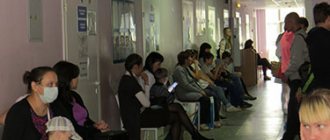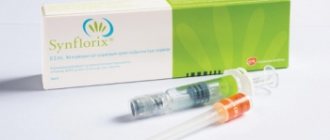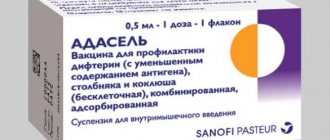Vaccination Center Inpromed
Sovigripp
Sovigripp
from 1000 rub.
Manufacturer Russia
Age For children from 6 months to 3 years, Sovigripp is administered twice with an interval of 4 weeks at a dose of 0.25 ml (1/2 dose). For children over 3 years of age and adults, Sovigripp is administered once at a dose of 0.5 ml.
Packaging0.5 ml
Flu vaccination is an effective way to protect against severe complications. The use of the drug Sovigripp reduces the risk of morbidity in adults and children; it is recommended for seasonal prevention. The highly purified composition is characterized by rare side effects and has a number of features when used.
Compound
The drug is effective against several common strains of influenza and contains hemagglutin of the following subtypes of the virus:
- A(H1N1) - 5 µg;
- type B - 11 µg;
- A(H3N2) - 5 µg.
Prescribed to prevent influenza infection during colds for children over 6 months, adults and the elderly. The composition includes auxiliary components that are necessary to maintain the activity of the non-magglutin virus: potassium dihydrogen phosphate, adjuvant SOVIDON, phosphate-saline solution. The manufacturer uses thiomersal as a preservative.
Which vaccine is suitable for children?
Both one and the other vaccines are completely identical. Regular monitoring by Roszdravnadzor allows us to cast aside all doubts about their safety. Therefore, both products are ideal for immunizing children.
Every year, changes occur in the composition of medications, which improves their quality and effectiveness in preventing influenza.
Everyone needs to be vaccinated - children and adults. The drugs have no toxic effects, so immunization is not prohibited during pregnancy. It is impossible to fully judge the effectiveness of the vaccine. Experts recommend getting vaccinated every year to prevent infection and complications during a flu epidemic.
Indications
The flu vaccine Sovigripp is prescribed as an effective preventive measure. Used annually during routine vaccination in the following groups of patients:
- children from 6 months without adding a preservative;
- patients over 18 years of age without age restrictions with a composition with the addition of thiomersal.
The main groups of people with indications for vaccination with Sovigripp:
- elderly – over 60 years old;
- patients suffering from chronic pathologies of the cardiovascular, endocrine, nervous systems, renal dysfunction, diabetes mellitus, metabolic disorders, severe anemia;
- patients with HIV, hepatitis, allergies;
- schoolchildren, students in a group, high-risk zone;
- children with weakened immune systems who often suffer from acute respiratory viral infections.
Sovigripp is recommended as protection against infection for people who, in the course of their daily work, come into contact with potential carriers of influenza. These include workers in medical, preschool and school institutions, food services, consumer services, and public passenger transportation. Vaccination reduces the incidence rate among military personnel, full-time students, elderly people living in a nursing home, or a sanatorium.
Sovgripp ® inactivated subunit influenza vaccine
Trade name.
SOVIGRIP®
Group name.
Influenza vaccine [inactivated].
Dosage form.
Solution for intramuscular administration.
The vaccine is a surface glycoprotein (hemagglutinin and neuraminidase), isolated from purified influenza virus virions of types A and B, obtained from virus-containing allantoic fluid of chicken embryos from clinically healthy chickens using chicken erythrocytes or erythrocyte-free technology in the production process, and diluted in phosphate-saline buffer solution, in combination with the adjuvant SOVIDON. The flu shot is available with a preservative - thiomersal (merthiolate), or without a preservative.
The antigenic composition of strains changes annually in accordance with WHO recommendations.
Compound.
1 dose (0.5 ml) contains:
Vaccine with preservative
- hemagglutinin of influenza virus subtype A(H1N1) - 5 μg;
- hemagglutinin of influenza virus subtype A (H3N2) - 5 μg;
- hemagglutinin of influenza virus type B - 11 mcg;
- adjuvant SOVIDON™ - 500 mcg;
- preservative - thiomersal (merthiolate) - (50.0 ± 7.5) mcg;
- phosphate-buffered saline solution - up to 0.5 ml.
Vaccine without preservative
- hemagglutinin of influenza virus subtype A(H1N1) - 5 μg;
- hemagglutinin of influenza virus subtype A(H3N2) - 5 μg;
- hemagglutinin of influenza virus type B - 11 mcg;
- adjuvant SOVIDON™ - 500 mcg;
- phosphate-buffered saline solution - up to 0.5 ml.
Note. Composition of phosphate-buffered saline solution No. 1 (for the drug without a preservative):
9 g of sodium chloride, 1.5 g of sodium hydrogen phosphate, 0.12 - 0.14 g of potassium dihydrogen phosphate, water for injection up to 1 liter.
Composition of phosphate-buffered saline solution No. 2 (for a drug with a preservative):
9 g of sodium chloride, 1.5 g of sodium hydrogen phosphate, 0.12 - 0.14 g of potassium dihydrogen phosphate, 0.85 ml of thiomersal (merthiolate) solution 1%, water for injections up to 1 l.
Description.
Colorless or slightly yellowish transparent or slightly opalescent liquid.
Immunological properties.
The vaccine forms high specific immunity against seasonal influenza.
Pharmacotherapeutic group.
MIBP vaccine.
ATX code. J07ВВ02 Indications for the use of influenza vaccinations Sovigripp.
For active annual preventive immunization against seasonal influenza, a preservative-free vaccine is used in children from 6 months of age, adolescents and adults without any age limit, and in pregnant women in the 2nd-3rd trimester of pregnancy;
vaccine with a preservative - in adults over 18 years of age. The vaccine is especially indicated. 1. Persons at high risk of illness and complications in case of influenza:
- persons over 60 years of age;
children of preschool age. schoolchildren; - persons who often suffer from acute respiratory viral infections; - persons suffering from chronic somatic diseases, including diseases and malformations of the cardiovascular, respiratory and central nervous systems, chronic kidney diseases, metabolic diseases, diabetes mellitus, chronic anemia, allergic diseases (except for allergies to chicken proteins); congenital or acquired immunodeficiency, including infection with the human immunodeficiency virus; - pregnant women. 2. Persons who, due to the nature of their educational or professional activities, have a high risk of contracting the flu or infecting others with it:
- students;
— medical workers; — workers in the social sphere, management, education, services, public catering, transport, trade; - military personnel, police. Contraindications for use.
1. Allergic reactions to chicken protein or other components of the vaccine.
2. Severe post-vaccination reactions (temperature above 40 °C, the appearance of edema at the site of vaccine administration, hyperemia over 8 cm in diameter) or post-vaccination complications (collapse, non-febrile convulsions, anaphylaxis) to the previous administration of influenza vaccine. 3. Pregnancy (when using a vaccine with a preservative). 4. Age up to 18 years (when using a vaccine with a preservative). 5. Age up to 6 months. Temporary contraindications.
1. Acute febrile conditions, acute infectious and non-infectious diseases, including the period of convalescence.
Vaccination is usually carried out 2-4 weeks after recovery. 2. Chronic diseases in the acute stage. Vaccination is carried out during the period of remission. The possibility of vaccination of persons suffering from chronic diseases is determined by the attending physician, based on the patient’s condition. 3. For mild forms of acute respiratory viral and intestinal infections, vaccination is carried out after the temperature has normalized and/or the acute symptoms of the disease have disappeared. Method of administration and dose.
- Vaccination is carried out annually in the autumn-winter period.
- Vaccination is possible at the beginning of an epidemic rise in the incidence of influenza.
- For children over 3 years of age, adolescents and adults without age restrictions, the vaccine is administered once intramuscularly into the upper third of the outer surface of the shoulder (in the area of the deltoid muscle) in a vaccination dose of 0.5 ml.
- For children from 6 months to 3 years, the vaccine is administered twice with an interval of 4 weeks into the anterior outer surface of the thigh intramuscularly in a vaccination dose of 0.25 ml (1/2 dose) according to the following administration regimen:
1. From an ampoule containing 0.5 ml (1 dose) of the drug, 0.25 ml of the vaccine is taken with a sterile syringe that has the appropriate graduation. The remainder of the vaccine in the ampoule must be discarded immediately. 2. When using a syringe containing 0.5 ml of the drug, it is necessary to remove half of the contents by pressing the syringe plunger to the corresponding mark on the syringe. The remaining amount of vaccine (0.25 ml) is administered to the patient. The opening of ampoules and the vaccination procedure are carried out in strict compliance with the rules of asepsis and antiseptics. The drug cannot be stored in opened ampoules/syringes
.
is NOT SUITABLE
for use in ampoules with altered physical properties (color, transparency), damaged integrity and labeling, expired shelf life, violations of storage and/or transportation conditions.
Precautions for use.
- Do not administer intravenously!
- On the day of vaccination, those vaccinated must be examined by a therapist/paramedic with mandatory thermometry. At temperatures above 37 °C, vaccination is not carried out.
- Vaccination sites must be equipped with anti-shock therapy. The vaccinated person must be under medical supervision for 30 minutes after administration of the drug.
Symptoms of overdose, measures to help in case of overdose.
Cases of overdose have not been established.
Side effect.
The vaccine is a highly purified drug and is well tolerated by those vaccinated.
The following reactions may develop: Very often (>1/10):
- local reactions: pain on palpation, induration, swelling and hyperemia of the skin at the injection site;
- systemic reactions: low-grade fever, malaise, headache, sore and sore throat, slight runny nose.
Often (1/10 -1/100):
- systemic reactions: dizziness, myalgia, arthralgia, abdominal pain, increased fatigue.
These local and systemic reactions are transient and disappear after 1-2 days without specific therapy. Very rare (< 1/10,000):
- with high individual sensitivity, allergic reactions may be observed: anaphylactic shock, angioedema, urticaria, rash (erythematous, papular), etc.
Interaction with other drugs.
The vaccine can be administered against the background of basic therapy for the underlying disease.
Vaccination in persons receiving immunosuppressive therapy may be less effective. The vaccine can be used simultaneously with other inactivated vaccines (with the exception of rabies). In this case, contraindications to each of the vaccines used must be taken into account; the drugs must be injected into different parts of the body with different syringes. Use during pregnancy and breastfeeding.
Data from clinical trials of the vaccine on pregnant women have shown that vaccination does not have a negative effect on the fetus, the body of the woman and the child and can be used during pregnancy.
Vaccination with this drug can be carried out starting from the second trimester of pregnancy. Experience with the use of inactivated influenza vaccines shows that vaccination of a woman during breastfeeding does not have a toxic effect on the child and can be used. The final decision to vaccinate pregnant and breastfeeding women should be made by a physician individually, taking into account the risk of contracting influenza and possible complications of influenza infection. Information about the possible effect of the drug on the ability to drive vehicles and machinery.
Not installed.
Release form.
Solution for intramuscular administration, 0.5 ml (1 dose) in ampoules or single-use syringes with a needle and protective cap.
10 ampoules each with instructions for use and an ampoule scarifier in a cardboard box (pack). 5 ampoules in a blister pack. 2 blister packs each with instructions for use and an ampoule scarifier in a cardboard pack. 10 ampoules in a blister pack. 1 blister pack with instructions for use and an ampoule scarifier in a cardboard box (pack). When packaging ampoules that have a break ring or a point for opening, an ampoule scarifier is not included. 1 syringe in a blister pack. 1 blister pack with instructions for use in a cardboard pack. 1 bottle with instructions for use in a cardboard pack. Expiration date.
1 year.
Do not use after the expiration date stated on the package. Transportation conditions.
Transport at temperatures from 2 to 8 °C.
Freezing is not allowed. Storage conditions.
Store at a temperature of 2 to 8 °C out of the reach of children.
Freezing is not allowed. Vacation conditions.
For medical institutions (vaccine in ampoules and disposable syringes). Available by prescription (vaccine in vials and disposable syringes). Registration certificate holder of JSC NPO Microgen Russia, 115088, Moscow, st. 1st Dubrovskaya, 15, building 2, tel. (495) 710-37-87, e-mail Organization receiving claims: JSC NPO Microgen Russia, 115088, Moscow, st. 1st Dubrovskaya, 15, building 2, tel. (495) 710-37-87, e-mail Manufacturer/production address: JSC NPO Microgen Russia, 450014, Republic of Bashkortostan, Ufa, st. Novorossiyskaya, 105, tel.; or FSUE SPbNIIVS FMBA of Russia Russia, 198320, St. Petersburg, Krasnoe Selo, st. Svobody, 52, tel., fax; or FORT LLC Russia, 390540, Ryazan region, Ryazan district, Okskoye s/p, 1z, tel..
Complaints regarding the quality of the drug, with the obligatory indication of the batch number and release date, as well as information about cases of increased reactogenicity or the development of post-vaccination complications, should be sent to the Federal Service for Surveillance in Healthcare (Roszdravnadzor) and to the organization receiving the claims, with subsequent submission medical documentation.
Contraindications
The drug Sovigripp is not recommended for patients with chicken protein intolerance or a severe allergic reaction to the active components in the vaccine. Among the main contraindications indicated by the manufacturer:
- pregnancy at any stage (in rare cases, vaccination with a composition without a preservative is allowed);
- a history of severe reactions to vaccinations with fever, swelling, the formation of a focus of hyperemia, coma or muscle cramps;
- child's age up to 6 months.
There are contraindications for which vaccination is not recommended until exacerbations are eliminated:
- acute stage of ARVI, rhinitis, seasonal allergies;
- intestinal infections;
- exacerbation of chronic pathologies, which is accompanied by changes in blood counts, chills, abnormal stool, and high fever;
- oncological diseases during active therapy (administration of the vaccine during remission is allowed).
In such situations, vaccination can be done as prescribed by a doctor after the acute symptoms disappear.
Which vaccine is more effective against influenza?
The therapeutic effect of Grippol plus and Sovigrippa is no different.
According to the opinion of many doctors, most are inclined to choose Sovigrippa. This is due to the wide range of therapeutic effects and few side effects.
Laboratory studies confirm the full compliance of vaccines with medical requirements.
The therapeutic duration of the products does not differ. Antiviral activity is noted 2-3 days after vaccination. The protective properties of pharmaceuticals last up to 6-12 months.
Interaction with other drugs
Sovigripp can be used simultaneously with a course of treatment for the underlying disease.
Drugs that have an immunosuppressive effect can reduce the effectiveness of the vaccine.
The simultaneous administration of Sovigripp and other inactivated vaccines for the prevention of infectious diseases (except for rabies) is allowed, subject to the following requirements:
- all vaccines must be drawn into separate syringes;
- the introduction of two or more drugs into one area of the body is unacceptable.
Which is better - Grippol plus or Sovigripp
There is no particular difference between the Grippol Plus and Sovigripp vaccines. Taking into account all the above information, we can conclude that pharmacological agents have a similar composition and side effects.
Both drugs are made in Russia, have a high degree of purification and fully comply with medical criteria.
The cost of a single dose of Sovigrippa is 200-250 rubles. The price of Grippol Plus is 2 times higher for a similar dosage and equals 430 rubles.
According to reviews, patients prefer the Sovigripp vaccine, noting its high effectiveness. Comparing the two drugs, Grippol plus is somewhat inferior to Sovigripp in quality and price.
What is the flu, and why is it dangerous?
Influenza is an acute respiratory viral infection characterized by:
- sudden and rapid onset;
- increase in body temperature to high numbers;
- chills;
- severe weakness;
- severe aches in muscles and joints;
- headache;
- photophobia, redness of the eyes.
A runny nose and sore throat with the flu are usually mild. Often patients are bothered by a dry, painful cough, which can persist for a long time.
The infection is transmitted by airborne droplets. Typically, the incubation period lasts several days. In this case, a person becomes contagious even before clinical symptoms.
Often, influenza cannot be distinguished from other viral infections. In order to do this, there is a special analysis. Unlike ARVI, influenza has more severe symptoms, a higher incidence of complications and a protracted course. Complications of influenza include: otitis media, bronchitis, laryngitis, pneumonia. In addition, the influenza virus causes specific complications, affecting the nervous system and skeletal muscles.
Is it possible to get vaccinated if you are allergic to chicken egg white?
Vaccine strains of the virus are grown on chicken egg whites. After cultivation, the drug is thoroughly cleaned of protein residues, but its microparticles are able to penetrate into the finished vaccine.
A number of studies have shown that the vaccine can only be dangerous if a person has an anaphylactic reaction to the eggs. A severe or moderate reaction to the protein does not in any way affect the tolerability of the vaccine. However, the final decision regarding a particular person always remains with the attending physician.






